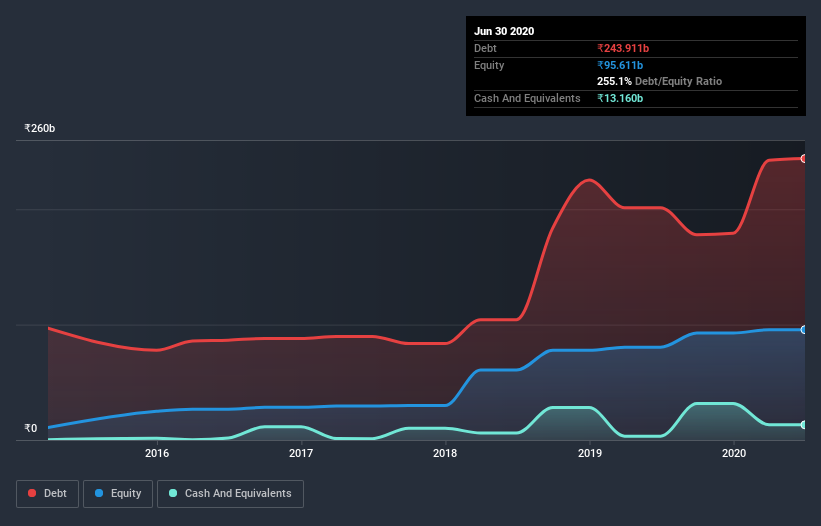- India
- /
- Electric Utilities
- /
- NSEI:ADANIENSOL
Does Adani Transmission (NSE:ADANITRANS) Have A Healthy Balance Sheet?

Legendary fund manager Li Lu (who Charlie Munger backed) once said, 'The biggest investment risk is not the volatility of prices, but whether you will suffer a permanent loss of capital.' When we think about how risky a company is, we always like to look at its use of debt, since debt overload can lead to ruin. As with many other companies Adani Transmission Limited (NSE:ADANITRANS) makes use of debt. But the real question is whether this debt is making the company risky.
What Risk Does Debt Bring?
Generally speaking, debt only becomes a real problem when a company can't easily pay it off, either by raising capital or with its own cash flow. In the worst case scenario, a company can go bankrupt if it cannot pay its creditors. However, a more common (but still painful) scenario is that it has to raise new equity capital at a low price, thus permanently diluting shareholders. Of course, the upside of debt is that it often represents cheap capital, especially when it replaces dilution in a company with the ability to reinvest at high rates of return. When we think about a company's use of debt, we first look at cash and debt together.
See our latest analysis for Adani Transmission
What Is Adani Transmission's Net Debt?
As you can see below, at the end of March 2020, Adani Transmission had ₹242.5b of debt, up from ₹201.4b a year ago. Click the image for more detail. However, it does have ₹13.2b in cash offsetting this, leading to net debt of about ₹229.3b.

How Healthy Is Adani Transmission's Balance Sheet?
Zooming in on the latest balance sheet data, we can see that Adani Transmission had liabilities of ₹53.8b due within 12 months and liabilities of ₹247.7b due beyond that. Offsetting these obligations, it had cash of ₹13.2b as well as receivables valued at ₹45.6b due within 12 months. So it has liabilities totalling ₹242.7b more than its cash and near-term receivables, combined.
This deficit is considerable relative to its market capitalization of ₹266.0b, so it does suggest shareholders should keep an eye on Adani Transmission's use of debt. This suggests shareholders would be heavily diluted if the company needed to shore up its balance sheet in a hurry.
In order to size up a company's debt relative to its earnings, we calculate its net debt divided by its earnings before interest, tax, depreciation, and amortization (EBITDA) and its earnings before interest and tax (EBIT) divided by its interest expense (its interest cover). The advantage of this approach is that we take into account both the absolute quantum of debt (with net debt to EBITDA) and the actual interest expenses associated with that debt (with its interest cover ratio).
Adani Transmission shareholders face the double whammy of a high net debt to EBITDA ratio (5.2), and fairly weak interest coverage, since EBIT is just 1.5 times the interest expense. The debt burden here is substantial. The good news is that Adani Transmission grew its EBIT a smooth 31% over the last twelve months. Like a mother's loving embrace of a newborn that sort of growth builds resilience, putting the company in a stronger position to manage its debt. When analysing debt levels, the balance sheet is the obvious place to start. But it is future earnings, more than anything, that will determine Adani Transmission's ability to maintain a healthy balance sheet going forward. So if you're focused on the future you can check out this free report showing analyst profit forecasts.
But our final consideration is also important, because a company cannot pay debt with paper profits; it needs cold hard cash. So we clearly need to look at whether that EBIT is leading to corresponding free cash flow. During the last three years, Adani Transmission produced sturdy free cash flow equating to 78% of its EBIT, about what we'd expect. This cold hard cash means it can reduce its debt when it wants to.
Our View
Adani Transmission's EBIT growth rate was a real positive on this analysis, as was its conversion of EBIT to free cash flow. But truth be told its interest cover had us nibbling our nails. We would also note that Electric Utilities industry companies like Adani Transmission commonly do use debt without problems. Looking at all this data makes us feel a little cautious about Adani Transmission's debt levels. While we appreciate debt can enhance returns on equity, we'd suggest that shareholders keep close watch on its debt levels, lest they increase. There's no doubt that we learn most about debt from the balance sheet. But ultimately, every company can contain risks that exist outside of the balance sheet. Consider risks, for instance. Every company has them, and we've spotted 1 warning sign for Adani Transmission you should know about.
At the end of the day, it's often better to focus on companies that are free from net debt. You can access our special list of such companies (all with a track record of profit growth). It's free.
If you decide to trade Adani Transmission, use the lowest-cost* platform that is rated #1 Overall by Barron’s, Interactive Brokers. Trade stocks, options, futures, forex, bonds and funds on 135 markets, all from a single integrated account. Promoted
New: Manage All Your Stock Portfolios in One Place
We've created the ultimate portfolio companion for stock investors, and it's free.
• Connect an unlimited number of Portfolios and see your total in one currency
• Be alerted to new Warning Signs or Risks via email or mobile
• Track the Fair Value of your stocks
This article by Simply Wall St is general in nature. It does not constitute a recommendation to buy or sell any stock, and does not take account of your objectives, or your financial situation. We aim to bring you long-term focused analysis driven by fundamental data. Note that our analysis may not factor in the latest price-sensitive company announcements or qualitative material. Simply Wall St has no position in any stocks mentioned.
*Interactive Brokers Rated Lowest Cost Broker by StockBrokers.com Annual Online Review 2020
Have feedback on this article? Concerned about the content? Get in touch with us directly. Alternatively, email editorial-team@simplywallst.com.
About NSEI:ADANIENSOL
Adani Energy Solutions
Generates, transmits, and distributes power in India.
Reasonable growth potential low.
Similar Companies
Market Insights
Community Narratives



